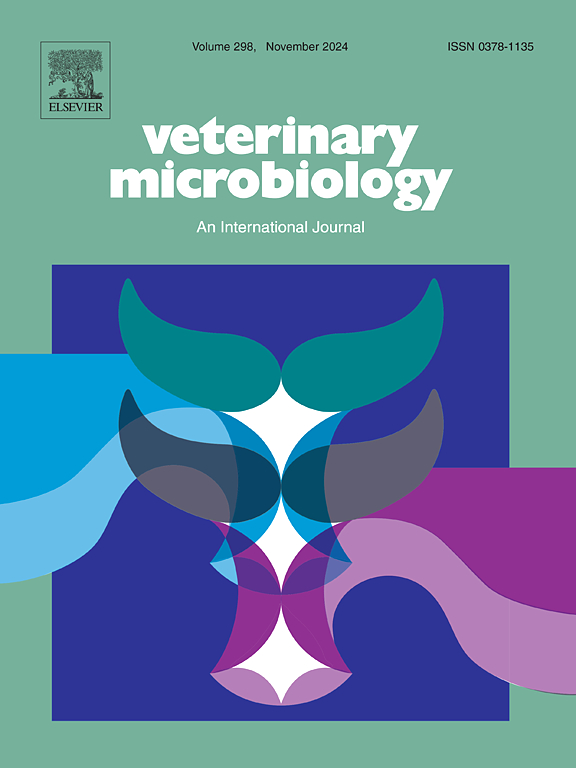Bacterial species associated with bovine digital dermatitis of Finnish dairy cows using 16S rRNA amplicon sequencing and Treponema species-specific 4-plex real-time PCR
IF 2.4
2区 农林科学
Q3 MICROBIOLOGY
引用次数: 0
Abstract
Bovine digital dermatitis (DD) is a widespread polybacterial skin disorder affecting dairy and beef cattle, leading to significant animal welfare and economic problems worldwide. The disease primarily affects the hind feet skin, causing painful inflammation between the heel bulbs and resulting in lameness. This study investigated the bacterial compositions in different DD lesion stages and in healthy skin biopsy samples from 151 dairy cows on 36 Finnish farms. The lesions were first classified into six categories, including healthy skin (M0) and samples from different DD lesion stages (M1-M4.1). Additionally, 13 healthy skin samples (M0HH) from cows in low DD (<5 %) prevalence herds served as controls. Bacterial profiling using 16S rRNA gene sequencing revealed the presence of three dominant phyla in active DD lesions: Firmicutes (39 %), Bacteroidota (31 %), and Spirochaetota (24 %), and altogether 11 Treponema species were detected. Real-time PCR was used to verify the presence of four common pathogenic considered species (T. phagedenis, T. denticola, T. medium and T. pedis), but only T. phagedenis, T. denticola were detected. This study indicated that DD is a polybacterial disease, with Treponema species abundant in active DD lesions. A higher Treponema count in Western Finland was associated with larger and more severe DD lesions, emphasizing the need for targeted and effective control measures in this region.
利用16S rRNA扩增子测序和密螺旋体物种特异性4-plex实时荧光定量PCR分析芬兰奶牛数字性皮炎相关细菌种类
牛数字性皮炎(DD)是一种广泛存在的多细菌皮肤病,影响奶牛和肉牛,在世界范围内导致重大的动物福利和经济问题。这种疾病主要影响后脚皮肤,引起后跟鳞茎之间疼痛的炎症,导致跛行。本研究调查了芬兰36个农场151头奶牛不同DD病变阶段和健康皮肤活检样本中的细菌组成。首先将病变分为6类,包括健康皮肤(M0)和不同DD病变阶段的样本(M1-M4.1)。此外,从低DD (<5 %)流行牛群中提取的13个健康皮肤样本(M0HH)作为对照。16S rRNA基因测序结果显示,在活动性DD病变中存在3个优势门:厚壁菌门(39 %)、拟杆菌门(31 %)和螺旋体门(24 %),共检测到11种密螺旋体。采用实时荧光定量PCR法检测了4种常见致病性考虑种(噬菌体、齿状体、中位体和足部体)的存在,但只检测到噬菌体和齿状体。本研究表明,DD是一种多细菌疾病,活跃的DD病变中有丰富的密螺旋体。芬兰西部较高的密螺旋体计数与较大和更严重的DD病变相关,强调需要在该地区采取有针对性和有效的控制措施。
本文章由计算机程序翻译,如有差异,请以英文原文为准。
求助全文
约1分钟内获得全文
求助全文
来源期刊

Veterinary microbiology
农林科学-兽医学
CiteScore
5.90
自引率
6.10%
发文量
221
审稿时长
52 days
期刊介绍:
Veterinary Microbiology is concerned with microbial (bacterial, fungal, viral) diseases of domesticated vertebrate animals (livestock, companion animals, fur-bearing animals, game, poultry, fish) that supply food, other useful products or companionship. In addition, Microbial diseases of wild animals living in captivity, or as members of the feral fauna will also be considered if the infections are of interest because of their interrelation with humans (zoonoses) and/or domestic animals. Studies of antimicrobial resistance are also included, provided that the results represent a substantial advance in knowledge. Authors are strongly encouraged to read - prior to submission - the Editorials (''Scope or cope'' and ''Scope or cope II'') published previously in the journal. The Editors reserve the right to suggest submission to another journal for those papers which they feel would be more appropriate for consideration by that journal.
Original research papers of high quality and novelty on aspects of control, host response, molecular biology, pathogenesis, prevention, and treatment of microbial diseases of animals are published. Papers dealing primarily with immunology, epidemiology, molecular biology and antiviral or microbial agents will only be considered if they demonstrate a clear impact on a disease. Papers focusing solely on diagnostic techniques (such as another PCR protocol or ELISA) will not be published - focus should be on a microorganism and not on a particular technique. Papers only reporting microbial sequences, transcriptomics data, or proteomics data will not be considered unless the results represent a substantial advance in knowledge.
Drug trial papers will be considered if they have general application or significance. Papers on the identification of microorganisms will also be considered, but detailed taxonomic studies do not fall within the scope of the journal. Case reports will not be published, unless they have general application or contain novel aspects. Papers of geographically limited interest, which repeat what had been established elsewhere will not be considered. The readership of the journal is global.
 求助内容:
求助内容: 应助结果提醒方式:
应助结果提醒方式:


